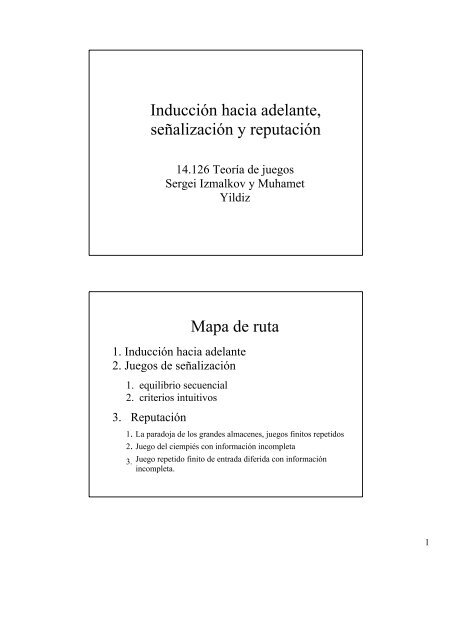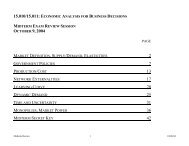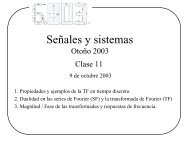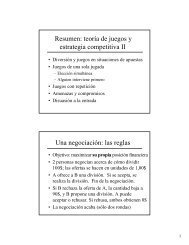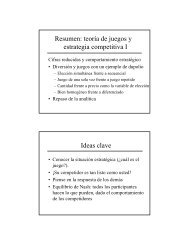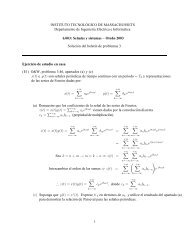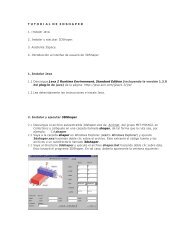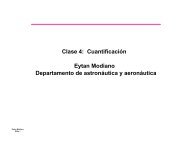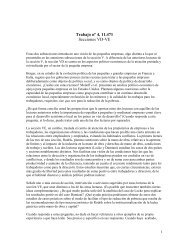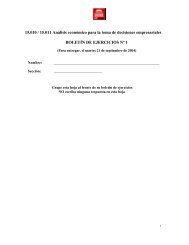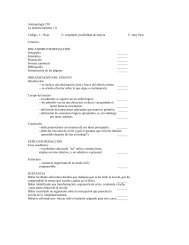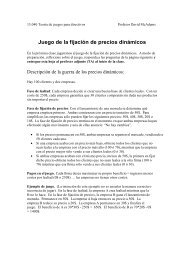Inducción hacia adelante, señalización y reputación Mapa de ruta
Inducción hacia adelante, señalización y reputación Mapa de ruta
Inducción hacia adelante, señalización y reputación Mapa de ruta
Create successful ePaper yourself
Turn your PDF publications into a flip-book with our unique Google optimized e-Paper software.
<strong>Inducción</strong> <strong>hacia</strong> <strong>a<strong>de</strong>lante</strong>,<br />
<strong>señalización</strong> y <strong>reputación</strong><br />
14.126 Teoría <strong>de</strong> juegos<br />
Sergei Izmalkov y Muhamet<br />
Yildiz<br />
<strong>Mapa</strong> <strong>de</strong> <strong>ruta</strong><br />
1. <strong>Inducción</strong> <strong>hacia</strong> <strong>a<strong>de</strong>lante</strong><br />
2. Juegos <strong>de</strong> <strong>señalización</strong><br />
1. equilibrio secuencial<br />
2. criterios intuitivos<br />
3. Reputación<br />
1. La paradoja <strong>de</strong> los gran<strong>de</strong>s almacenes, juegos finitos repetidos<br />
2. Juego <strong>de</strong>l ciempiés con información incompleta<br />
3.<br />
Juego repetido finito <strong>de</strong> entrada diferida con información<br />
incompleta.<br />
1
<strong>Inducción</strong> <strong>hacia</strong> <strong>a<strong>de</strong>lante</strong><br />
La batalla <strong>de</strong> los sexos con<br />
opciones exteriores<br />
2,2<br />
1<br />
B S<br />
B 3,1 0,0<br />
S 0,0 1,3<br />
2
<strong>Inducción</strong> <strong>hacia</strong> <strong>a<strong>de</strong>lante</strong><br />
• Hay que interpretar las acciones como<br />
resultados <strong>de</strong> elección consciente incluso<br />
las que están fuera <strong>de</strong>l curso normal.<br />
• Criterio intuitivo<br />
• Teorías falsas<br />
Creencia firme en la racionalidad<br />
En cualquier historial <strong>de</strong>l juego, se asume que<br />
cada agente es racional si es posible. (Esto es,<br />
si hay dos estrategias s y s’ <strong>de</strong> un jugador i<br />
que son coherentes con un historial <strong>de</strong>l juego,<br />
y si s es estrictamente dominada pero s’ no, en<br />
este historial ningún jugador j cree que i juega<br />
s.)<br />
3
5<br />
0<br />
1<br />
1<br />
2<br />
3<br />
1<br />
2<br />
Ejemplos<br />
1<br />
2<br />
3<br />
2<br />
0<br />
1<br />
1<br />
2<br />
Quemar dinero<br />
1<br />
0 D BB BS SB SS<br />
B S B S<br />
0B<br />
B 3,1 0,0 B 2,1 -1,0 0S<br />
S 0,0 1,3 S -1,0 0,3 DB<br />
DS<br />
3<br />
1<br />
2<br />
1<br />
2<br />
3<br />
O T H E R<br />
4
id<br />
Tabla para el juego <strong>de</strong> subasta<br />
min<br />
Ui = 20(2+2minjbidj - bidi)<br />
1 2 3<br />
1 60 - -<br />
2 40 80 -<br />
3 20 60 100<br />
Equilibrio Nash <strong>de</strong>l juego <strong>de</strong> subasta<br />
• 3 equilibrios: s 1 = todos juegan 1; s 2 = todos<br />
juegan 2; s 3 = todos juegan 3.<br />
• Asuma que los jugadores tiemblan con la posibilidad <strong>de</strong><br />
que ε < 1/2 y juegan cada estrategia no planeada w.p.<br />
ε/2. p. ej. w.p. ε/2, piensan que se va a jugar otro equilibrio<br />
- s 3 es un equilibrio si y sólo si<br />
- s 2 es un equilibrio si y sólo si<br />
- s 1 es un equilibrio si y sólo si<br />
5
1<br />
0.8<br />
0.6<br />
0.4<br />
0.2<br />
0<br />
-0.2<br />
-0.4<br />
-0.6<br />
0.047<br />
(1-ε /2 ) n -1/2<br />
-0.8<br />
(1-ε )<br />
-1<br />
0 0.032 0.05 0.1 0.15 0.2<br />
n +(1 ε /2 )<br />
-<br />
n -1<br />
Juego <strong>de</strong> subasta con tarifa <strong>de</strong> entrada<br />
Cada jugador <strong>de</strong>ci<strong>de</strong> primero<br />
si jugar en el juego <strong>de</strong><br />
subasta (E o X); si juega,<br />
ha <strong>de</strong> pagar una tarifa p ><br />
60.<br />
Por cada m =1,2,3, ∃ SPE: (m,m,m) se juega en la subasta y<br />
los jugadores juegan si y sólo si 20(2+m) ≥ p.<br />
Bid<br />
<strong>Inducción</strong> <strong>hacia</strong> <strong>a<strong>de</strong>lante</strong>: cuando 20(2+m) < p, (Em) es<br />
estrictamente dominada por (Xk). Tras E, ningún jugador asignará<br />
probabilidad positiva a una puja mínima ≤ m. Equilibrio FI:<br />
(Em,Em,Em) don<strong>de</strong> 20(2+m) ≥ p.<br />
¿Y si hay una licitación antes <strong>de</strong> la puja?<br />
min 1 2 3<br />
1 60 - -<br />
2 40 80 -<br />
3 20 60 100<br />
6
Señalización<br />
Mo<strong>de</strong>lo<br />
• Jugadores: (S)en<strong>de</strong>r, (R)eceiver<br />
1. La naturaleza selecciona t <strong>de</strong> T – la<br />
distribución <strong>de</strong> probabilidad es π<br />
2. S observa t, y envía mensaje m <strong>de</strong> un conjunto M;<br />
3. R observa m – pero no t – y realiza la acción a;<br />
4. S obtiene U S (t,m,a) y R obtiene U R (t,m,a).<br />
Esto es sabido por todos.<br />
7
Cerveza - Quiche<br />
1<br />
1<br />
0<br />
1<br />
cerveza<br />
cerveza<br />
quiche<br />
quiche<br />
3<br />
0<br />
0<br />
0<br />
2<br />
1<br />
2<br />
0<br />
1<br />
0<br />
3<br />
1<br />
tw<br />
ts<br />
{.1}<br />
{.9}<br />
Buen equilibrio<br />
1<br />
1<br />
0<br />
1<br />
cerveza<br />
cerveza<br />
quiche<br />
quiche<br />
3<br />
0<br />
0<br />
0<br />
2<br />
1<br />
2<br />
0<br />
1<br />
0<br />
3<br />
1<br />
tw<br />
ts<br />
{.1}<br />
{.9}<br />
8
1000002<br />
-999999<br />
0<br />
1<br />
2<br />
0<br />
3<br />
1<br />
1<br />
0<br />
0<br />
1<br />
2<br />
0<br />
1<br />
0<br />
1000003 -<br />
1000000 3<br />
1<br />
$1M<br />
$1M<br />
Mal equilibrio<br />
cerveza<br />
cerveza<br />
{.9}<br />
{.1}<br />
tw<br />
ts<br />
quiche<br />
quiche<br />
Cerveza - Quiche - M<br />
1<br />
cerveza<br />
cerveza<br />
{.9}<br />
{.1}<br />
tw<br />
ts<br />
quiche<br />
quiche<br />
1<br />
1<br />
0<br />
0<br />
1<br />
0<br />
0<br />
3<br />
0<br />
2<br />
1<br />
$1M 1000003 -<br />
3<br />
1000000<br />
0<br />
$1M 1000002<br />
2 -999999<br />
1<br />
9
Cho -- Kreps<br />
• T(m); M(t); A(m)<br />
• El conjunto <strong>de</strong> acción es finito;<br />
• ρ(m;t) = probabilidad <strong>de</strong> que t envíe m<br />
• φ (a;m) = probabilidad <strong>de</strong> que R elija a,<br />
•<br />
• Para el subconjunto I <strong>de</strong> T,<br />
• MBR<br />
• Creencias:<br />
µ(t │m) =<br />
Equilibrio secuencial<br />
• está<br />
maximizada en m.<br />
• φ (.;m) está en MBR(µ(.|m),m)<br />
10
Prueba <strong>de</strong> un equilibrio<br />
• U*(t) = utilidad esperada <strong>de</strong> tipo t en equilibrio;<br />
1. Escoja un criterio, diciendo que el mensaje fuera<br />
<strong>de</strong> equilibrio particular (OEM) no se pue<strong>de</strong> enviar<br />
por algún tipo t. Diga también, que a no se tomará<br />
en respuesta a m si a no está en BR(T(m),m).<br />
Itere. [T s (m)]<br />
2. Para cada OEM m, consi<strong>de</strong>re todas las<br />
respuestas <strong>de</strong> equilibrio secuenciales <strong>de</strong> R a m<br />
en el juego original. Todos ellos son racionales<br />
secuencialmente, dado T s (m). Si no, FALLO.<br />
Dominancia<br />
• Para cada OEM m, elimine t si ∃ m’ s.a.<br />
0<br />
0<br />
0<br />
0<br />
m’<br />
m’<br />
{.9}<br />
{.1}<br />
tw<br />
ts<br />
m<br />
m<br />
a1<br />
a1<br />
a2<br />
a2<br />
-1<br />
0<br />
1<br />
1<br />
-1<br />
1<br />
-1<br />
0<br />
11
Dominancia <strong>de</strong> equilibrio<br />
& criterio intuitivo<br />
Dominación <strong>de</strong> equilibrio: ∀ OEM m, elimina<br />
(t,m) si<br />
Criterio intuitivo: ∀ OEM m, <strong>de</strong>fine<br />
entonces el equilibrio no cumple el criterio <strong>de</strong> intuición.<br />
0<br />
1<br />
2<br />
0<br />
3<br />
1<br />
1<br />
0<br />
Mal equilibrio<br />
cerveza<br />
cerveza<br />
{.9}<br />
{.1}<br />
tw<br />
ts<br />
quiche<br />
quiche<br />
1<br />
1<br />
0<br />
0<br />
3<br />
0<br />
2<br />
1<br />
12
1000002<br />
-999999<br />
0<br />
1<br />
2<br />
0<br />
3<br />
1<br />
1<br />
0<br />
0<br />
1<br />
2<br />
0<br />
1<br />
0<br />
1000003 -<br />
1000000 3<br />
1<br />
$1M<br />
$1M<br />
Buen equilibrio<br />
cerveza<br />
cerveza<br />
{.9}<br />
{.1}<br />
tw<br />
ts<br />
quiche<br />
quiche<br />
Cerveza - Quiche - M<br />
1<br />
cerveza<br />
cerveza<br />
{.9}<br />
{.1}<br />
tw<br />
ts<br />
quiche<br />
quiche<br />
n<br />
1<br />
1<br />
0<br />
0<br />
1<br />
0<br />
0<br />
3<br />
0<br />
2<br />
1<br />
$1M 1000003 -<br />
3<br />
1000000<br />
0<br />
$1M 1000002<br />
2 -999999<br />
1<br />
13
X<br />
Reputación<br />
Entrada diferida<br />
1 Enter 2 Acc.<br />
(0,1) (-1,-1)<br />
Fight<br />
(1,0)<br />
14
1,1<br />
C<br />
Entrada diferida, repetida dos<br />
veces, muchas veces<br />
Acc.<br />
1<br />
Fight<br />
-1,0<br />
2 Enter<br />
X<br />
X<br />
1 Enter<br />
1<br />
0,2<br />
X<br />
2 Acc. 1 Enter 2<br />
Fight<br />
X<br />
Acc.<br />
Fight<br />
(1,1) 0,-1<br />
1 Enter 2 Acc.<br />
0,-1<br />
-1,0 (-2,-2)<br />
¿Qué ocurriría si se repitiese n veces?<br />
2<br />
Fight<br />
Repetida dos veces PD<br />
C<br />
C D C D<br />
D<br />
C D C D<br />
10<br />
10<br />
5<br />
11<br />
11<br />
5<br />
6<br />
6<br />
C<br />
5<br />
11<br />
C<br />
D<br />
0<br />
12<br />
1<br />
D<br />
2<br />
1<br />
1<br />
C D C D<br />
2<br />
2<br />
2<br />
1<br />
2,0<br />
C D C D C D C D C D<br />
6<br />
6<br />
1<br />
7<br />
11<br />
5<br />
6<br />
6<br />
¿Qué ocurriría si T = {0,1,2,…,n}?<br />
D<br />
12<br />
0<br />
7<br />
1<br />
6<br />
6<br />
1<br />
7<br />
7<br />
1<br />
2<br />
2<br />
15
1<br />
1<br />
1<br />
1<br />
0<br />
3<br />
Juego <strong>de</strong>l ciempiés<br />
1 2 1 1 2 1 2<br />
2<br />
2<br />
…<br />
98<br />
98<br />
97<br />
100<br />
99<br />
99<br />
98<br />
101<br />
Juego <strong>de</strong>l ciempiés – con duda<br />
{.999}<br />
197 5 4 3 2 1 = n<br />
1 2 2 1 2 1 2<br />
{.001}<br />
-1<br />
1<br />
0<br />
3<br />
0<br />
3<br />
…<br />
…<br />
96<br />
99<br />
∝5<br />
0<br />
99<br />
98<br />
98<br />
-1<br />
98<br />
97<br />
100<br />
99<br />
99<br />
0<br />
100<br />
-1<br />
99<br />
98<br />
101<br />
1 2 2 1 2 1 2<br />
∝3<br />
∝1<br />
0<br />
101<br />
100<br />
100<br />
100<br />
100<br />
0<br />
100<br />
16
Hechos sobre el ciempiés<br />
• Cada conjunto <strong>de</strong> información <strong>de</strong> 2 se alcanza con<br />
probabilidad positiva.<br />
• 2 siempre pasa con probabilidad positiva.<br />
• Si 2 estrictamente prefiere pasar en n, entonces<br />
1<br />
1<br />
- 1 <strong>de</strong>be preferir estrictamente pasar en n+1,<br />
- 2 <strong>de</strong>be preferir estrictamente pasar en n+2,<br />
- su posterior en n es su anterior.<br />
• Por cualquier n > 2, 1 pasa con probabilidad<br />
positiva. Si 1 pasa w/p 1 en n, entonces el 2<br />
posterior en n-1 es su anterior.<br />
Juego <strong>de</strong>l ciempiés – con duda<br />
{.999}<br />
197 5 4 3 2 1 = n<br />
1 2 2 1 2 1 2<br />
-1<br />
1<br />
0<br />
3<br />
0<br />
3<br />
…<br />
…<br />
96<br />
99<br />
0<br />
99<br />
98<br />
98<br />
-1<br />
98<br />
97<br />
100<br />
99<br />
99<br />
0<br />
100<br />
-1<br />
99<br />
98<br />
101<br />
1 2 ∝5 2 1 ∝3 2 1 ∝1 2<br />
{.001}<br />
0<br />
101<br />
100<br />
100<br />
0<br />
100<br />
17


